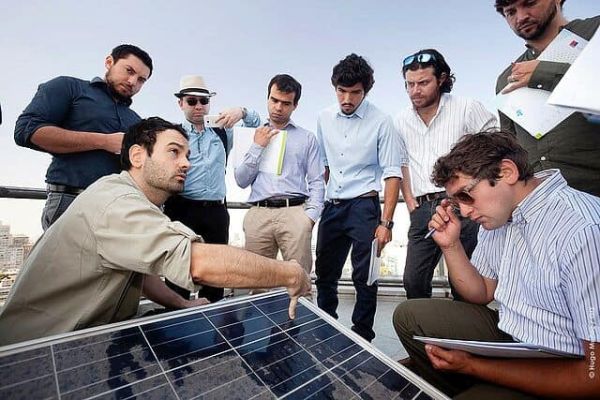NAMA Support Project Strengthens Chile’s Technical Capacities in Renewable Energy: Technical Cooperation End-of-Component Report Released

Capacity building event in February 2018. Demonstration of the proper use of the photovoltaic technology
The Technical Cooperation (TC), one of two components of the NAMA Support Project Chile Self-Supply Renewable Energy (SSRE), has ended after 3.5 years of implementation. Marking the TC’s completion, Deutsche Gesellschaft für Internationale Zusammenarbeit (GIZ) GmbH, the project’s Delivery Organisation, submitted an end-of-project report of the TC reflecting on TC’s achievements and lessons learnt.
With a budget of approx. EUR 3 million earmarked for the TC, activities focused on awareness-raising and capacity-building to promote development of SSRE projects. The TC component also supported the Chilean government in improving political and regulatory conditions on the SSRE market.
How the SSRE Project Came to be
The idea to target the SSRE market was conceived in 2014, when the Chilean Ministry of Energy (MoE), supported by several national and international organisations [1], submitted a Proposal to the NAMA Facility. The idea behind the SSRE project’s Theory of Change was straightforward yet ambitious – to push forward the renewable energy sector on a small- and medium scale, enabling local micro-, small and medium enterprises (MSMEs) to shift to renewables and generate electricity and thermal energy for own use.
To trigger this transformation, GIZ implemented the TC in coordination with MoE, to enhance the capacities of local entrepreneurs in developing high-quality feasible SSRE projects. Later, the Support Project added political and regulatory activities. For example, the establishment of a Monitoring, Reporting and Verification (MRV) system equipped the Chilean government with a standardised tool for quantifying SSRE technology- driven GHG emission reductions.
The FC implemented by Kreditanstalt für Wiederaufbau (KfW) in cooperation with MoE and the Economic Development Agency of the Ministry of Economy (CORFO) aims to finance pre-feasibility studies and support front-runners financially, enabling SSRE project implementation. Trainings to the banking sector and establishment of a guarantee fund would constitute the final steps in creating a stable basis for SSRE proliferation.
Challenges and Opportunities for Technical Cooperation
Since 2014, the SSRE project has faced both challenges and opportunities, which are further explained in the final project report. The former has altered the SSRE project’s pace and integrity, delaying the FC and preventing simultaneous implementation of the two components. Fortunately, the latter helped establish the TC as a timely and necessary intervention, backed by the Chilean government’s solid commitment to decarbonise the economy and promote renewables.
Overall Achievements
The TC component has managed to achieve and, in some cases, overachieve its targets:
- 985 decision-makers in private and public sectors benefited directly from the Support Project’s trainings, capacity-building and awareness-raising events;
- Nearly 500 entrepreneurs completed professional training courses on SSRE project analysis, management and development;
- More than 660 SSRE installations were registered in the industrial, agricultural and commercial sectors;
- 22 studies, videos and brochures, ranging from user guides to market analyses were developed;
- First-of-their-kind studies for heat pumps and biomass boilers and heaters on the Chilean market were conducted;
- 2 MRV systems were established to quantify GHG emission reductions, covering separately small-scale renewable projects for self-supply and large-scale projects connected to transmission lines; and
- More than 3,400 SSRE projects were assessed with annual emission reductions of 12 MtCO2e (an equivalent of 6 million gasoline cars not driving for a year) verified through the MRV systems.
Though the accomplishments listed prove the TC’s success, the stages that relied on establishing and delivering the financial mechanism had limited success. Out of 229 SSRE projects that received professional technical advice from GIZ and MoE under the TC’s Help Desk, only four became a reality utilising their own funding. The remaining projects could not be implemented in the absence of the financial mechanism, which was to be offered by the then non-operational FC.
Lessons Learnt and the Way Forward
“The NAMA Support Projects are special as they foster broad alliances and encourage strong partners’ involvement. The impact is simply much broader”, said the project director of the now completed TC, Mr. David Fuchs. For him, the Support Project has been about bringing together multiple stakeholders and engaging governmental actors creating projects that are nationally owned, timely and reflective of the practical needs of key target groups at different levels of decision-making across private and public sectors.
Differing timelines of the technical and financial sides of the SSRE project remain a challenge but may be overcome without compromising the SSRE project’s Theory of Change. In the upcoming years, the FC will have to amplify and build on the “technicians’” work to trigger transformational changes in the financial sector. It will involve changing the perception of small- and medium scale SSRE solutions in the eyes of local financing institutions and easing access to finance for promising SSRE projects. Ultimately, the result would be both perpetual and tangible, demonstrating that SSRE solutions can effectively help Chile to deliver on its climate goals.
More information about the Chile SSRE can be found on the webpage of the Support Project and in the End-of-Project report of the TC submitted by GIZ in the Knowledge & Learning Hub.
This Support Project is being implemented as part of a climate finance initiative under the NAMA Facility to steer countries towards carbon-neutral development pathways. NAMA Support Projects are generally designed to catalyse transformational change through the cohesive actions of the Technical and the Financial Components. The Technical Component should serve to create an enabling technical and socio-political environment for the mitigation technologies and practices in the target sector, whereas the Financial Component should channel financial flows into this sector to support its further transformation towards carbon neutrality.
[1] National Center for Innovation and Promotion of Sustainable Energies (CIFES; formerly – the Renewable Energy Centre (CER)), Economic Development Agency of the Ministry of Economy (CORFO), the Ministry of Environment, the Chilean International Cooperation Agency (AGCI), Deutsche Gesellschaft für Internationale Zusammenarbeit (GIZ) GmbH and Kreditanstalt für Wiederaufbau (KfW)
